Apiculture (Beekeeping) Farmer Facing TIMPs
Beekeeping is an important economically viable agricultural enterprise that can be practiced in all agro-ecological. However, it is important for the beekeeper to understand what entails beekeeping in order to benefit most from the enterprise. This publication provides some lessons that beekeepers can use to enhance their skills in production and eventually make money out of the enterprise.
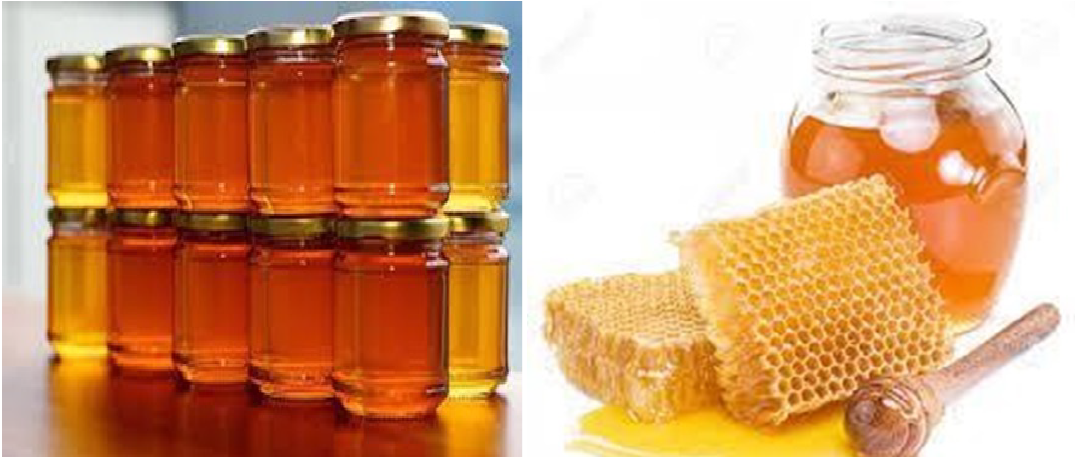
Packed processed honey in bottles
The beekeeping industry mainly uses honey bees (scientifically referred as Apis mellifera). There are various races of these bees in Kenya for example: the mountainous bees (occurring in mountainous or highlands), the semi-arid bees (in the vast part of Kenya), the coastal bees (in the coastal lowlands) and the arid bees (in the arid areas especially northern Kenya). These honey bees are firstly different in occurrence but there are areas where they have cross bred.
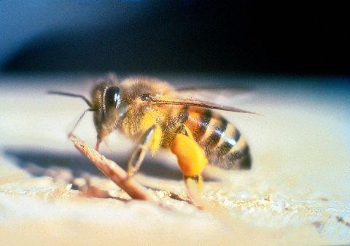
Adult Apis mellifera scutellata
Source:www.insectimages.com
The above photograph shows an adult apis mellifera scutellata found in the plains
There is growing need to expand beekeeping and include the Stingless bees, which are completely different insects from honeybees. They produce honey, however, they are smaller and their production unit very small.
How to ensure you succeed in beekeeping as business
1. Decide on type of hive you want to invest in
- The choice of hive is critical as it will help in deciding what kind of investments you will make
- The common beehives: The Kenya Top Bar Hive (KTBH), improved KTBH, Langstroth hive, Box hive, Log hive and their other modifications.
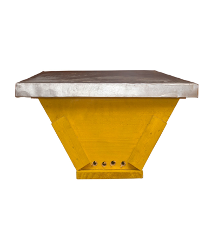
KTBH
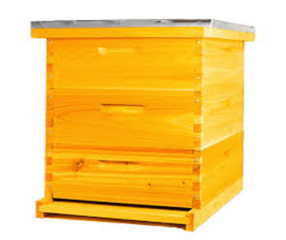
Langstroth hive

Traditional Log hive
Source: Kalro Perkerra
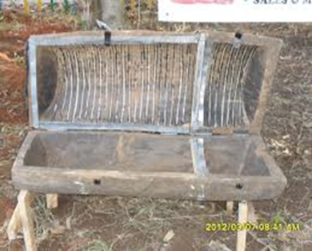
Kapkuikui superlog hive
- These hives differ in
- Apiary setting/placement
- Inspections
- Harvesting
- Honey processing
- Honey quality control, assurance, management
- Pricing per unit
2. Decide on the site where your hives will be placed
- Consider carrying capacity, e.g. if you have only 1 ha of undisturbed land:
- Does it have abundant flowers?
- How often do you get flowers?
- Consider safety and security matters
- Prevent stoning of hives by playful kids and possible attack by passerby.
- Prevent disturbance by grazing animals
- Avoid areas with disturbing sound
- Avoid active road network that causes sound disturbance, emissions that can get into honey.
- Creating a flight path by erecting a barrier of 5-7 feet to ensure bees fly above the normal height of people or animals hence preventing direct contact.
- Source of shade for the hives
- Hives are self-contained houses of bees, extreme interference must be avoided to keep them from moving away.
- Protect hives from direct sun burn by placing them on or under shade - trees, placing grass thatches/makuti on the hive roof/top, providing shaded constructed areas.
3. Apiary management
- Apiary is where you keep your hives for bee settlement;
- Can be a single tree where you are hanging a hive
- Under shaded tree where hives are placed on ground
- A fenced area with hives, or even a house constructed to keep hives inside.
- The purpose of apiary is placement of hives for colonization, and subsequent ease in handing the bee colonies
- Keep the apiary clean by cutting grass and trim branches that reach the hives to prevent pests such as ants from crawling into the hives.
- Grease wires holding the hives to control particularly the ants.
- Remove old combs from the hives to prevent the wax moth infestation.
- Inspect hives regularly to monitor bee progress to ensure they are not attacked by pests.
- Inspect the hives once a week by opening them and once a month without opening them. Inspection should be done daily by simply looking without opening them.
- Do not spill honey near the apiary. It will attract pests and cause the bees to fight with other bees from other nearby hives.
3. Nutrition management
- Locate bees in areas with abundant and diverse floral resources to help them stay healthy.
- Avoid locations with too many colonies as it results in inadequate floral resources, hence may encourage spread of bee diseases and parasites.
- Supplement feeding by preparing sugar syrup when there is food shortage for the bees.
4. General colony observation
- Observing bees for a few minutes helps to know whether they are collecting pollen.
- If they are, it indicates that the bees are feeding the young.
- It shows that the bees are healthy and have a laying Queen.
5. Pests and predators
a) Safari & other Ants:
- Hang hives and grease hanging wires regularly.
- Spread ashes around the posts holding hives.
- Keep grass short and branches from touching the hives.
- Make hive parts to fit together without gaps.
- If hives are on stands, place the legs of the stands in tins of old engine oil.
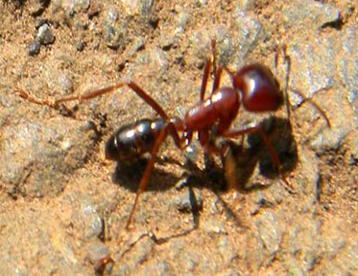
Safari Ant
b) Honey badger
- Hang the hives securely to prevent the badger knocking them down.
- Avoid placing hives on stands as they are prone to attack by the honey badger
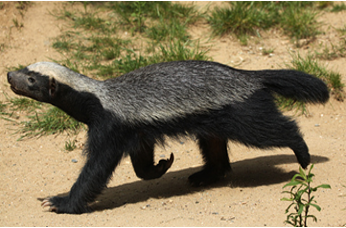
Honey badger
c) Termites:
- Treat posts used for hanging with wood preservative.
- Use metallic poles.
d) Hive Beetles
- Use of holes instead of slits for the entrance.
- Hand pick or destroy them if found in hives.
e) Birds (Honey guides)
- Don't leave brood combs exposed.
- Scare birds away.
Colony Housing
1. Improved Kapkuikui Super Log Hive
- Improved from the traditional log hive.
- Honey is not mixed with brood during harvesting.
- Enhances honey quality.
- Minimizes absconding of bees.
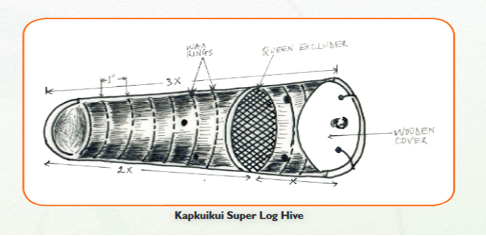
Source: www.kalro.org
How to make Kapkuikui Super Log Hive
1. Split a hollow wooden log into two halves of same length.
2. The 2 ends are fitted with wooden cylindrical covers.
3. Inside has a framework of wax rings that bees construct honey combs.
2. Improved Kenya Top Bar Hive
- Modified from the existing KTBH.
- Consists of one chamber complete with top bars and lid.
- Made with high roof for enough air circulation.
- More bee occupancy and enhanced productivity.
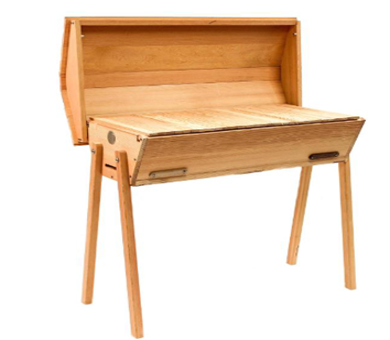
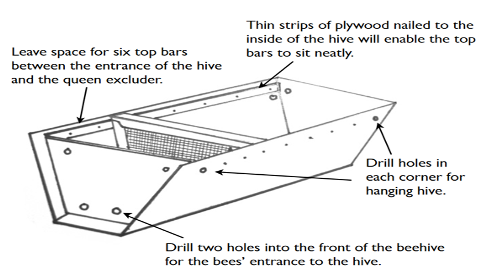
Source: www.kalro.org
Design and materials of KTBH
- Plywood of 9mm is suitable as it is easy to cut and nailed to desired shape.
- Standard 9mm plywood of 2.4m x 1.2m – will be enough for 3 hives measuring 80 cm long.
- Top bars 44cm long are cut from strips of natural wood of cedar or grevillea are used.
- Top bars must be 3.2m wide and grooves or points can be curved to encourage bees to lay down wax.
Feeding equipment
Mainly used when feeding sugar syrup to honeybee colonies
1) Feeder Box:
- It has same length as the top bar of a KTBH and shaped as the hive, with both sides covered with hard board.
- The slot on either side of its upper part gives entry for bees to get to the syrup.
- Sugar syrup is poured through the opening at the top frame and floater straws prevent bees from drowning.
- One empty top bar is removed and replaced with the feeder.
- The feeder should be replenished with fresh syrup when it ferments as this will affect the bees if left.
- After the bees are fed remove the feeder box and replace the top bar or frame.
2) Plastic bag feeder
- Cans or pails of sugar syrup are placed on top bars or the frames within the brood chamber.
- A super without frames is then placed on top of the brood chamber and the hive cover placed over it.
- The cans or pails containing sugar syrup can also be placed on top of the hive, however this will encourage robbing.
3) Combs within the brood chamber
- The sugar syrup is poured directly into the cells of empty combs on either top bars or frames.
- It’s then placed into the hive in the brood area/chamber tilted at an angle of 10º-20º to the horizontal over a large pan or tube to provide support.
4) Plastic bag feeder
- The plastic bag encloses much of one or two frames in the out edge of the brood nest, bees feed from the upper opening just like they do from a feeder box.
Other equipments

Uncapping fork
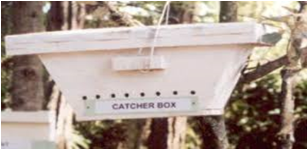
KTBH catcher box
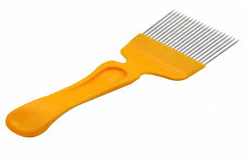
Uncapping fork
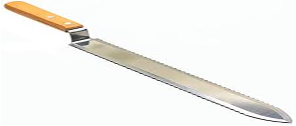
Honey bees knife
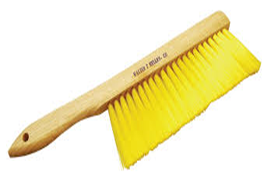
Bee brush
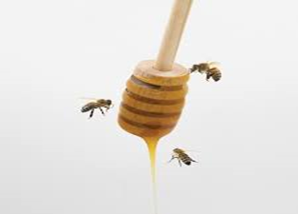
Honey sampler
Feed Formulation
- The natural food of the honeybee consists of nectar, honey, pollen and water.
- It is normally not necessary to feed bees in this country because plants providing pollen and nectar are usually abundant.
- However, under certain conditions feeding can have a beneficial effect to the colony.
These conditions are as follows:
- A new colony that has entered a hive by itself or that has transferred from a catcher box or made by division of bees will develop much faster if it is fed.
- About two litres of sugar syrup should be given for 2-3 weeks.
- Drought Conditions:
- During severe drought, bees should be fed to prevent them from migrating.
- The amount of feed requires understanding of both the bees and local conditions so that the sugar is not wasted.
Stimulative Feeding:
- When a honey-flow is expected to begin, the bees may be fed for two months before flowering to stimulate brood rearing.
- This will help the adult bees to be ready to forage in the field at on-set of flowering.
- Stimulative feeding enhances storage of more surplus honey as bees do not have to build up their numbers for the honey-flow.
- Feed two litres each week, however, this amount can be increased with time to keep pace with the increased number of bees.
- General rules for feeding honeybee colonies
- The beekeeper needs to know that:
- The best feed is comb of sealed honey, when not available sugar syrup made from beet or cane sugar is the alternative.
- Feeding changes the guard behaviour of the fed colony thus permitting unchallenged entry by robbers.
- Use standard feeder to enable the colonies to clear all syrup in a short time; this ensures the sugar syrup does not get spoilt.
- The feed should be placed close to the bees as possible for better results.
- Pollination is very important for reproduction to take place in flowering plants.
- The honey bee plays a major role as a pollinator by transporting pollen hence contributes to fertilization.
- Some crops such as apples, cranberries, melons, carrots and broccoli are 90% dependent on honey bee pollination.
- Integration of such crops in the bee surrounding enhances increased crop and as well as honey production.
- Important for a beekeeper to increase plants in his beekeeping business for pollination to enhance increased yields.This approach will enhance sustainable and increased honey production.
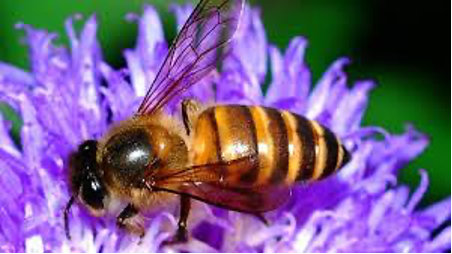
Source:www.owlcation.com
- Introduction of bee pasture targets increased floral resources for foraging while conserving the environment.
- Leads to increased honey production and quality.
- Identify, establish and conserve bee friendly plants to provide alternative bee forage sources.
- Contribute to reduced land degradation as a result of overgrazing, charcoal burning among others.
Table showing Stages against no of days taken
|
|
QUEEN |
WORKER |
DRONE |
|
Egg to Larva |
3 Days |
3 Days |
3 Days |
|
Larva to Pupa |
5 Days |
6 Days |
7 Days |
|
Pupa to adult |
7 Days |
11 Days |
14 Days |
|
Total no. of days |
15 Days |
20 Days |
24 Days |
How to ensure your bees are healthy
Disease and pest Control
- Inspect the apiary regularly and maintain hygiene by bush as a routine.
- Fence - off the apiary to exclude predators
- Physical removal of pest during inspection
- Suspension of the hives (hanging)
- Greasing of the hanging wires
- Use of the wood that are resistant to termites e.g. cedar
- Putting affected frames in hot water to destroy wax moths and other pests
- Adopting standard hive specifications
- Controlling chemical spraying – toxicity
- Avoiding areas with insect host trees/plants
- Trapping of honey badgers and other predators
- Provision of water
- General preventive measures
Prevention
- Record Keeping is very important in beekeeping as outlined below:
- Helps the farmer to gain knowledge on the enterprise
- Determine if the hive has the right queen
- It is easy to keep track of the production
- Guide in monitoring infestations and diseases
- Helps to improve production through hive inspections
- Facilitates team work
- Availability of information to meet legal requirements
- Enables tracking of finances
- Participate in surveys
- Types of beehive records to keep
- Apiary records
- Equipment records
- Hive records
- Inspection records
- Harvest records
- Financial records
- How to keep beehive records
- Mental notes and simple reminders
- Pen and paper records
- Audio and photo records
- Beekeeping records
- typed notes
- beekeeping record apps
Record keeping helps the beekeeper to learn about his/her bees for better management and decision making.
The use of efficient harvesting and processing methods can enhance value of hive products, this involves use of modern equipment in harvesting, storage and processing. This reduces wastage attributed to old methods that lead to wastage.
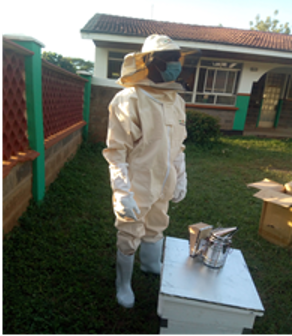
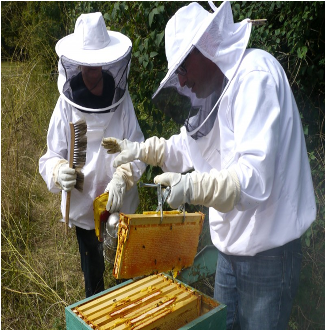
Beef honey harvester in protective attire Inspection of the hive
Source: www.morningchores.com
Time of Harvesting:
- Harvest honey during dry spells, i.e. between July to September, November and December to March.
- The time of harvest depends on the right time in the region.
- Where bee plants are common such as coffee, sunflower etc., harvest after the flowers have dried.
- Inspect hives during nectar flow to ensure harvesting as soon honey is ready, avoid harvesting unripe.
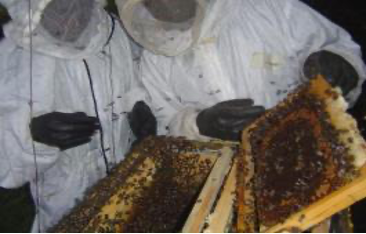
inspection of frames in a langstroth hive. Source: © Thomas Caroll, Kenya (2006)
- Ideal harvesting time of the day should be from 5.30 p.m. to 7.30 p.m.
Procedure of harvesting:
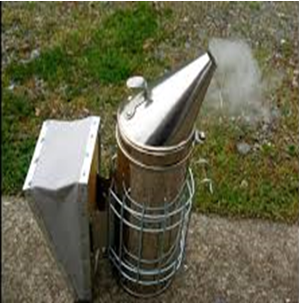
Smoker Protective clothing
Source:Kalro Perkerra
- Put on protective clothing ensure you are sting proof.
- You will need a smoker in good working condition and a clean dry plastic bucket with lid for storing the honey.
- The hive entrance is smoked with about 8 to 10 puffs, then the lid is opened and smoked again.
- Leave the hive for a minute or two before opening the lid to allow the smoke to affect the bees. Smoke causes the bees to engorge themselves with honey making it difficult for them to bend to sting (they become too full!).
- Tap the top bars with a hive tool. A hollow sound will indicate where there is no comb.
- Remove a top bar from the hive which has no comb attached. This allows you to examine the rest of the bars in the hive.
- Honeycombs are usually at the end of the hive opposite the entrance.
- Select combs that are 3/4 or more full of honey (these combs are ripe and have a low moisture content (<19%).
- This ensures that the honey will not ferment later when bottled. Leave the combs with brood and pollen for future production of honey.

Hand held refractometer: used to measure moisture content
Source:www.vietiinh.us
Honey Processing
- Personal hygiene is very important for the person handling.
- Depending on the bee hive you can either squeeze the honey out or extract it from the extractor.
- Extractor makes the process easier and less messy and leaves the combs intact.
- You get quality honey without dirt, debris, wax residue, pollen, and brood.
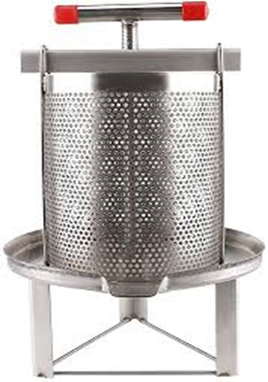
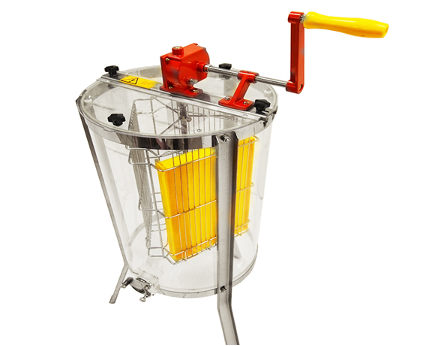
Honey press machine
Package honey in either plastic or glass jars which should be clean and dry and label.
- Keep honey in a cool place away from direct sunlight in a tightly sealed container.
- Use the original container it came in or a glass jar or food-safe plastic container will work.
- Avoid storing honey in metallic containers since honey is acidic.
- Honey is a major ingredient used to prepare many other products that are of benefit to the human body.
- Honey is used as a sweetener in various recipes as well.
1 hive =2,500/-
Yield of honey/hive (raw honey) =24kg harvested two times/year.
10 hives can yield=10*24kg equal KES 144,000 per year@600 per kg.
There is a high demand for honey and other hive products in Kenya and a readily available market as well. In fact demand exceeds the supply hence a guarantee of market for honey locally
https://www.kcsap.go.ke/wp-content/uploads/2020/09/Bee-Keeping-Article.pdf
Kenya Agricultural and Livestock Research Organization
P.O. Box 57811-00200, Nairobi, Kenya
Website:www.kalro.org
Callcentre: 0111010100